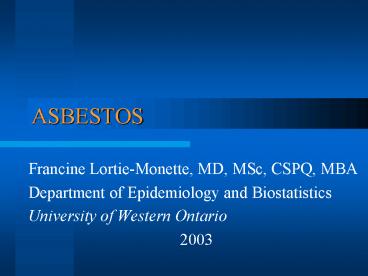ASBESTOS - PowerPoint PPT Presentation
Title: ASBESTOS
1
ASBESTOS
- Francine Lortie-Monette, MD, MSc, CSPQ, MBA
- Department of Epidemiology and Biostatistics
- University of Western Ontario
- 2003
2
Asbestosis
- Asbestosis is a model for other dust diseases as
well as other forms of pulmonary fibrosis - Some dust diseases take years for clinical
symptoms to develop
3
Dust Diseases
- Following removal from exposure, coal
pneumoconioses may stop progressing but - Silicosis and asbestosis often do progress
4
Asbestosis
- Model for
- Restrictive ventilatory impairment (vs
obstructive) - Interstitial lung disease
5
Why Study Asbestosis?
- Exposure has continued in European construction
industry till the mid-1970s - What about developing countries?
6
Why Study Asbestosis?
- The resulting epidemic of mesothelioma in
building workers born after 1940 did not become
apparent until the 1990s owing to the long
latency of the disease - Incidence rates are still rising
7
ASBESTOS
- A broad term for a group of naturally occurring
fibrous mineral silicates of magnesium and iron. - Asbestos-containing rock is mined, crushed and
milled to obtain fibrous material, processed
further into finer fibers.
8
ASBESTOS
- Asbestos fibers are categorized into 2 groups
- Amphiboles
- Serpentines
9
ASBESTOS Amphiboles (straight fibers)
- Those used commercially include
- Amosite (brown)
- Anthophylite
- Crocidolite (blue)
- Others (e.g. tremolite and actinolite) are
frequent contaminants of other silicates,
including some vermiculites and talcs.
10
ASBESTOS Serpentines
- Used commercially
- Chrysotile (3MgO-2SiO2-2H2O)
- (the most common)
11
The Characteristics of ASBESTOS
- Natural resistance to heat and acid
- Tensile strength
- Remarkable thermal, electrical and sound
insulating properties - Have resulted in thousands of commercial
applications, including floor tiles, boiler and
pipe insulation, roofing materials, brake
linings, and cement pipes.
12
Routes of Exposure
- Some ingestion (e.g. contaminated water)
- Mostly inhalation
- Aerosols generated by mining, milling,
product-manufacture, end use of product, and
disturbance of asbestos-containing materials
(e.g. renovations)
13
Pathogenesis
- Fibers provoke the accumulation of macrophages in
alveolar ducts and peribronchial regions, which
become thickened. - This fibrotic process progresses, leading to a
stiffened, smaller lung with diminished capacity
for gas exchange. - Progression can occur after exposure has ceased,
due to the retention of fibers in the lung and
persistent inflammatory response.
14
Effects
- Pulmonary Fibrosis
- Pleural Thickening
- Pleural Effusion
- Cancer
15
Pulmonary Fibrosis
- Results in restrictive lung disease that
generally becomes manifest clinically 15-20 years
after the onset of exposure.
16
Pulmonary Fibrosis (Contd)
- Most Prominent Symptom
- Insidious onset of dyspnea on exertion
- Signs
- End-inspiratory basilar rales which persist after
cough - Decreased forced vital capacity (FVC), total lung
capacity (TLC) and diffusing capacity (DLCO) - Eventually, extensive fibrosis obstructs the
blood flow throughout the pulmonary bed, causing
pulmonary hypertension and compensatory right
ventricular hypertrophy.
17
Benign Pleural Effusion
- May occur within the first 10 years of exposure,
and may be the first manifestation of illness. - Diagnosis by exclusion, i.e. negative cultures
of pleural fluid and pathological examination
showing no malignant cells. - Patients may be asymptomatic spontaneous
resorption may occur within several weeks.
18
Pleural Thickening (localized or diffuse)
- The most common consequence of occupational
exposure to asbestos. - Latency 20, and up to 40 years.
- Associated with reduced FVC
19
Lung Cancer
- Latency of ? 20 years.
- Same cell types and histological features as
other primary lung cancers.
20
Malignant Mesothelioma of the pleura and
peritoneum
- Considered a signal neoplasm because of its
rarity in the absence of exposure to asbestos. - Latency ? 20 years
- Presenting symptoms often are chest pain and
dyspnea, due to pleural effusions. - At high concentrations cancer of the
gastrointestinal tract, kidney, pancreas and
larynx (also post ingestion).
21
Asbestos
- Summary of a typical case
- Severe restrictive pulmonary impairment with
progressive dyspnea on exertion - No response to steroids
- Deteriorates without ongoing exposure hypoxemia
develops - Severe exercise limitation, with arterial
desaturation - Ultimately terminal respiratory failure
22
Silicosis
- Silica hard crystalling mineral, silicon dioxide
(SiO2), known as quartz - Commonly found in most igneous rocks and most
types of sand
23
Silicosis
- Persons at risk
- Hard rock miners (gold, iron, uranium)
- Smelter workers
- Sand-blasters
24
Silicosis
- Most silicosis results from chronic exposure over
years - Acute silicosis can occur from high exposure
(sand-blasters), and can cause death from massive
pulmonary fibrosis.
25
Silicosis recommended reading
- Finkelstein MM Silica, silicosis, and lung
cancers a risk assessment. - Am J Ind Med 2000 38 8-18
- Copies will be available at LRC on February 10,
2003































